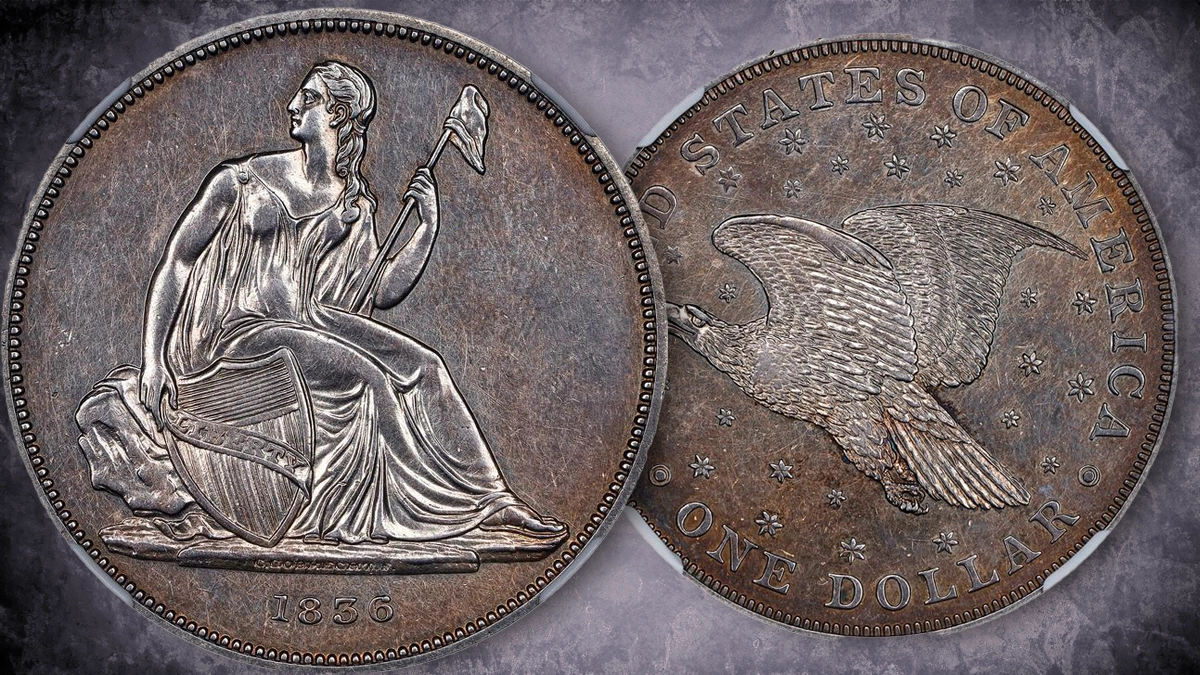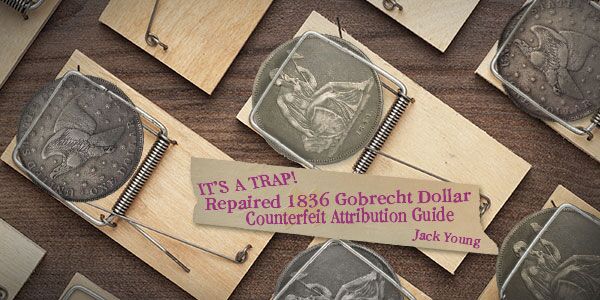
By Charles Morgan and Hubert Walker for CoinWeek Notes …..
The Mint’s First Attempt to Bring Back the Silver Dollar
The suspension of silver dollar production was lifted in 1831 under United States Mint Director Samuel Moore, enabling the resumption of the mintage of a coin not made in this country since 1804. It wasn’t until 1835 under Mint Director Robert M. Patterson, however, that efforts to produce the coin moved forward. The dollar was considered important to the nation’s image, even if it wasn’t an important part of circulating coinage; silver dollars were large and bulky, circulating mostly in the hard-money, western mining-interests states. Patterson wanted to produce coins of “exceptional artistic merit,” as one later scholar described it, in keeping with the Neoclassical movement prevalent at the time.
Engraver Christian Gobrecht prepared dies based on designs by Thomas Sully (Liberty) and Titian Peale (the eagle). The image of a seated Liberty was the main obverse design element, with nothing else except the date and the designer’s name. Approximately 18 coins from the first dies prepared were struck as patterns, and the design was approved by President Andrew Jackson and his cabinet. Unfortunately, the prominent placement of Gobrecht’s name on the obverse led to charges of conceit, even though the inclusion was per Director Patterson’s specific authorization. The criticisms were blunted by moving Gobrecht’s name to a less conspicuous location at the base of Liberty, and 1,000 coins were produced in late 1836.
The Mint Act of 1837 slightly reduced the weight of the silver dollar and changed the alloy to a composition of 90% silver and 10% copper. Under the new weight and fineness standard, 600 additional dollars were struck in 1837 but the coins were also dated 1836. The 1837 coins were struck in “medal” alignment: that is, the top of the reverse is at the top when, starting with the obverse facing the viewer in an upright orientation, the coin is rotated about a vertical axis either to the left or to the right. The original 1836 issues were minted in typical “coin” alignment: the bottom of the reverse is at the top when, starting with the obverse facing the viewer in an upright orientation, the coin is rotated about a vertical axis either to the left or to the right.
Though intended for circulation, all Gobrecht Dollars were minted with a Proof finish – an unusual situation in American coinage. Restrikes of the Gobrecht Dollar were made from the late 1850s through the late ’60s to meet growing collector interest. These dollars were produced in a variety of coin-turn and medal-turn alignments, often from mismatched obverse/ reverse die pairings, and some in copper rather than silver. The total number of restrikes produced is unknown but may have exceeded the original mintages. The restrikes are not considered official issues.
Certified Gobrecht Dollars
Almost 800 Gobrecht Dollars are listed in the current census and population reports, all as Proofs, the total including both originals and restrikes. Coin alignment 1836 original dollars appear more frequently in certification totals than 1836 original medal alignment pieces, though there is no apparent price distinction between the two (eye appeal/uniqueness are more significant). Original 1839 dollars are more expensive than original 1836 issues as PR50 and finer. Restrikes were produced in both silver and copper, and the copper examples are further described as Brown (BN), Red-Brown (RB), and Red (RD); fewer than 10 copper pieces are identified as such in certification totals.
All Gobrecht Dollars are scarce or rare, and expensive, even at lower grades, becoming very expensive as PR62 or finer.
Counterfeits

Gobrecht Dollars are rare and valuable and a number of known counterfeits exist. Learn how to identify some of those common examples in the marketplace with these articles by coin expert and CoinWeek contributor Jack D. Young.
Design
Obverse:
The obverse of the Gobrecht Dollar displays Liberty seated on a rock in Classical flowing robes, head turned toward her right (viewer’s left). Her left arm is bent, raised hand holding a liberty pole with a cap. The right arm is extended downward at her side, with the hand balancing a shield across which the word LIBERTY is displayed in a curving banner. Her feet and the shield rest on an even base, likely also of stone. The coin circumference is defined by a raised rim with a concentric circle of denticles to the inside, and the edge of the coin is plain.
The date is centered at the bottom, below the rock base, and the rest of the field is clear of design elements, giving a medallic impression. The first 1836 patterns contained the designer’s name as C. GOBRECHT F., the “F” an abbreviation for the Latin word fecit (“X made it” or “he made it”; thus, “C. Gobrecht Made It”) just below the base, above the date. The designer’s name was later moved to the edge of the rock base.
Dollars of 1838 (all known pieces are considered restrikes) and 1839 have 13 six-pointed stars surrounding the seated figure, seven on the left side, one between Liberty’s head and the cap, and the remaining five along the right. Gobrecht’s name was omitted from 1838 and 1839 dollars, and the edge of the coin is reeded instead of plain.
Reverse:
On the reverse, an eagle, wings uplifted in flight, dominates the center. The eagle flies upward on 1836-dated dollars, based on relative orientation to the obverse, within a field of 26 six-pointed stars. Half of the stars are slightly larger to represent the original 13 states with the smaller stars indicating the 13 states most recently added to the Union. Inside a raised rim and circle of denticles is a concentric circle of text, UNITED STATES OF AMERICA around the top two-thirds of the coin, with the denomination ONE DOLLAR completing the circle at the bottom. The two phrases are separated by centered dots highlighted by a small raised ring.
Dollars of 1838 and 1839 have no reverse stars, and the eagle flies horizontally based on relative orientation to the obverse. No mintmark appears on Gobrecht Dollars. Restrikes duplicate the original designs along with some additional variations, although on 1836 restrikes, the eagle flies horizontally.
Varieties
Several varieties exist, both in the original production and in the later restrike issues. Varieties are defined by die alignment, number, and placement of stars, metal composition, and obverse/reverse pairings. Research continues into both the definition of original and restrike issues, identification of die states and die pairings, and classification of identifying features.
Coin Specifications
| Gobrecht Dollar | |
| Years of Issue: | 1836-39 |
| Mintage (Circulation): | All were struck in Proof finishes, though issues were intended to and some did circulate. |
| Mintage (Proof): | High: 1,000 (1836, originals); Low: 300 (1839, originals) |
| Alloy: | .8924 silver, .1076 copper, early 1836 originals; .900 silver, .100 copper, all others 1836-39. |
| Weight: | 26.96 g, early 1836 originals; 26.73 g, all others 1836-39. |
| Diameter: | 39.00 mm |
| Edge: | Plain edge on 1836-dated originals, reeded edge on 1839 originals; all others are either plain or reeded. |
| OBV Designer: | Christian Gobrecht, based on designs by Thomas Sully and Titian Peale |
| REV Designer: | Christian Gobrecht, based on designs by Thomas Sully and Titian Peale |
* * *
References
Bowers, Q. David. A Buyer’s Guide to Silver Dollars and Trade Dollars of the United States. John Dannreuther (editor). Zyrus Press.
–. A Guide Book of United States Type Coins. Whitman Publishing.
–. The Experts Guide to Collecting & Investing in Rare Coins. Whitman Publishing.
Garrett, Jeff, and Ron Guth. Encyclopedia of U.S. Gold Coins 1795-1933. Whitman Publishing.
Judd, J. Hewitt. United States Pattern Coins. Q. David Bowers (editor). Whitman Publishing.
Taxay, Don. The U.S. Mint and Coinage. Arco Publishing.
Yeoman, R.S., and Jeff Garrett (editor). The Official Red Book: A Guide Book of United States Coins. Whitman Publishing.
* * *


